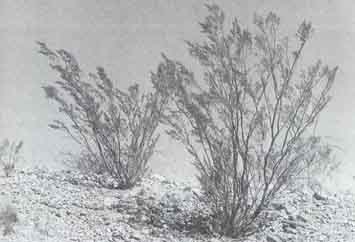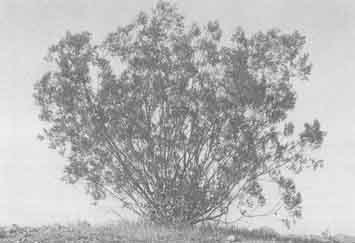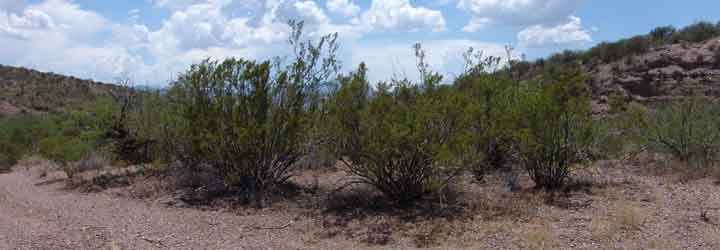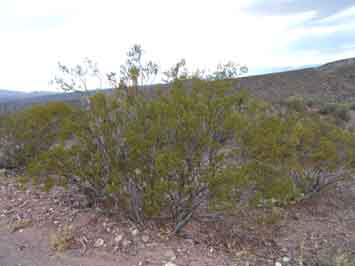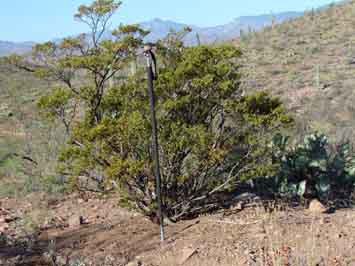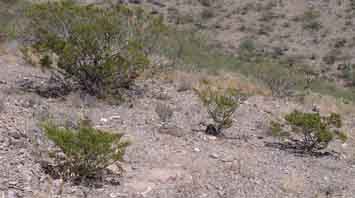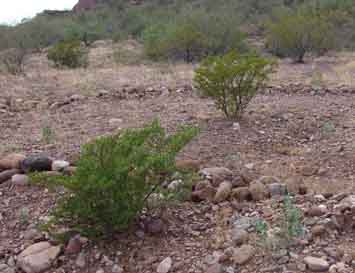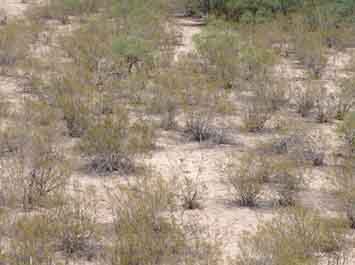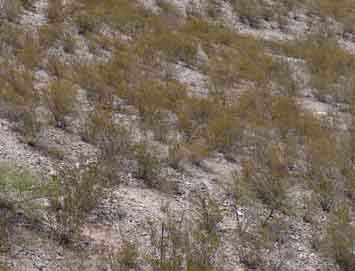Chihuahuan Creosotebush & Sonoran Creosotebush
Sources: Brown, David & Charles Lowe, 1980, Biotic Communities of the Southwest, Republished by University of Utah Press, 1994; Brown, David, ed., 1994, Biotic Communities: Southwestern United States and Northwestern Mexico, Salt Lake City: University of Utah Press.
Click on each image to enlarge.
The two juxtaposed images above are adapted from Brown, "Chihuahuan Desert Scrub", in Brown & Lowe 1980, cited above, pp. 172-3. According to Brown (p. 173), the figures in the image on the left typify the "Chihuahuan ecotype" of Creosotebush, while the image on the right typifies the "Sonoran ecotype" of Larrea tridentata. The Chihuahuan type plants "are shorter, have sparser foliage and straighter stems, and are more open at the base than their Sonoran counterparts", which "have a fuller, less angular appearance", and the two types also differ in their characteristic numbers of chromosomes: n=13 in the Chihuahuan, n=26 in the Sonoran. We set aside here the third member of the set, the Mohave ecotype, which is characterized as "shorter and bushier than the Sonoran Desert form", and which has n=39 chromosomes. (Ibid.)
We lack the ability to compare chromosomes on these plants, but based on observation of the creosotebush in our area, we would say that most anyway of the plants in the vicinity of Hot Springs Canyon look like the Sonoran Desert ecotype rather than the Chihuahuan. Here are some images:
Below, a view looking downstream in Upper Pool Wash.
Below, fairly typical creosotebushes on the left and right terraces in Lower Hot Springs Canyon.
All of these -- and they are quite typical plants in their overall shape and the distribution of branches and leaves -- seem quite obviously to be of the Sonoran Ecotype. Even the very small creosotebushes we see have this character: at left, three small creosotebushes in the foreground near the section 8 gate on the Ridge Road; at right, two small ones in the foreground (some larger ones also visible in the background) on a terrace in Lower Hot Springs Canyon.
Compare these small plants with the small one shown at the far left of the top-left banner photo above, representing a small Chihuahuan ecotype. Of these small plants only the center one above left approaches the distinctive angularity and openness of the Chihuahuan.
These plants share features distinguishing them from the Chihuahuan Ecotype as identified by Brown -- they have both denser foliage and a much less angular appearance. And while we have not conducted anything like a systematic survey, we feel considerable confidence in the statement that these are by far the more common appearances of creosotebushes in our area.
We will do more research on this subject as time permits. For now, two photographs taken near Tres Alamos Wash -- more than 15 miles south of our immediate area and well within the boundary of an ecozone most authorities agree is outside of our Arizona Uplands Sonoran Desert -- may serve for an initial comparison, showing stands of creosotebush that look like this: (Click on each image to enlarge it.)
These photographs were taken from some distance, so detail is poor, but impressionistically it looks like some of these plants may be the Chihuahuan Ecotype, though others appear to be Sonoran. To be continued....
